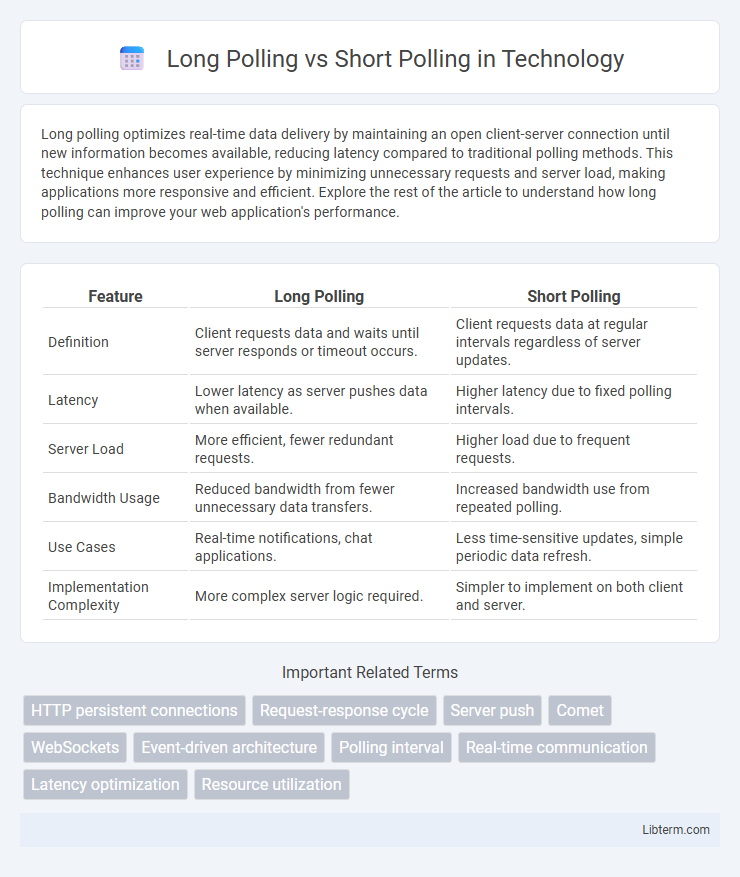Long polling optimizes real-time data delivery by maintaining an open client-server connection until new information becomes available, reducing latency compared to traditional polling methods. This technique enhances user experience by minimizing unnecessary requests and server load, making applications more responsive and efficient. Explore the rest of the article to understand how long polling can improve your web application's performance.
Table of Comparison
| Feature | Long Polling | Short Polling |
|---|---|---|
| Definition | Client requests data and waits until server responds or timeout occurs. | Client requests data at regular intervals regardless of server updates. |
| Latency | Lower latency as server pushes data when available. | Higher latency due to fixed polling intervals. |
| Server Load | More efficient, fewer redundant requests. | Higher load due to frequent requests. |
| Bandwidth Usage | Reduced bandwidth from fewer unnecessary data transfers. | Increased bandwidth use from repeated polling. |
| Use Cases | Real-time notifications, chat applications. | Less time-sensitive updates, simple periodic data refresh. |
| Implementation Complexity | More complex server logic required. | Simpler to implement on both client and server. |
Introduction to Polling in Web Communication
Polling in web communication is a technique where a client repeatedly requests data from a server to check for updates. Short polling involves frequent requests at set intervals, which can lead to increased server load and latency, while long polling maintains an open connection allowing the server to respond immediately when new data is available, reducing unnecessary network traffic. Efficient polling mechanisms are critical for real-time applications such as chat services and live notifications.
What is Short Polling?
Short polling is a client-server communication technique where the client repeatedly sends requests to the server at regular, fixed intervals to check for new data or updates. This method often leads to increased network traffic and latency due to frequent requests, regardless of whether new information is available. Short polling is simpler to implement but less efficient compared to long polling, which waits for server responses only when data changes occur.
How Long Polling Works
Long polling works by the client sending a request to the server and the server holding the connection open until new data is available or a timeout occurs, reducing unnecessary requests. When new data arrives, the server responds immediately, allowing the client to process updates in near real-time. This method minimizes latency and bandwidth usage compared to short polling, which repeatedly sends requests at fixed intervals regardless of new data availability.
Key Differences Between Long Polling and Short Polling
Long polling maintains an open connection between the client and server until new data is available, reducing server requests and latency, whereas short polling repeatedly sends requests at fixed intervals regardless of new data presence. Short polling can lead to higher server load and unnecessary network traffic due to frequent polling, while long polling optimizes resource usage by minimizing redundant requests. The choice between long and short polling impacts responsiveness, scalability, and real-time data delivery in applications.
Performance Impact of Long vs Short Polling
Long polling reduces latency and server load by maintaining open HTTP connections until new data is available, leading to more efficient resource utilization compared to short polling's frequent request intervals. Short polling generates increased network traffic and higher CPU usage due to continuous client-initiated requests regardless of data availability, resulting in potential performance bottlenecks under heavy load. Optimized long polling implementations minimize response times and server resource consumption, providing better scalability and user experience for real-time applications.
Use Cases for Long Polling
Long polling is ideal for real-time applications that require timely updates without continuous client-side requests, such as chat applications, live notifications, or collaborative editing tools. It reduces server load and latency by holding the client request until new data is available, making it suitable for use cases where instant feedback and reduced network overhead are critical. Unlike short polling, which frequently sends requests regardless of data changes, long polling optimizes resource use by only responding when necessary.
Use Cases for Short Polling
Short polling is ideal for scenarios where infrequent updates are sufficient, such as checking email inboxes or monitoring system statuses at regular intervals. It reduces server load and complexity compared to continuous connections, making it suitable for applications with low to moderate real-time requirements. Short polling fits well in environments where timely data retrieval outweighs the need for immediate responsiveness.
Scalability Considerations
Long polling reduces server load and improves scalability by keeping connections open until new data is available, minimizing frequent client requests compared to short polling's constant request intervals. Short polling can overwhelm servers with repetitive queries, especially as client numbers grow, leading to increased latency and resource consumption. Therefore, long polling is preferred in scalable applications requiring efficient real-time data updates and reduced network overhead.
Security Concerns in Polling Techniques
Long Polling reduces the risk of repeated exposure to attack vectors by maintaining open connections only until data is received, minimizing frequent request headers that can be intercepted. Short Polling exposes applications to higher risks such as denial-of-service (DoS) attacks due to its constant and rapid request cycles, increasing server load and network traffic vulnerability. Implementing secure transport layers like HTTPS and authentication tokens is crucial in both techniques to safeguard data integrity and prevent unauthorized data access during polling processes.
Choosing the Right Polling Method for Your Application
Long polling maintains an open connection until new data is available, reducing latency and server load, which is ideal for real-time applications like chat or notifications. Short polling repeatedly requests data at fixed intervals, leading to higher overhead but simpler implementation, making it suitable for less time-sensitive scenarios. Evaluate factors such as server capacity, network traffic, and user experience requirements to select the appropriate polling method for your application's performance and scalability needs.
Long Polling Infographic

 libterm.com
libterm.com